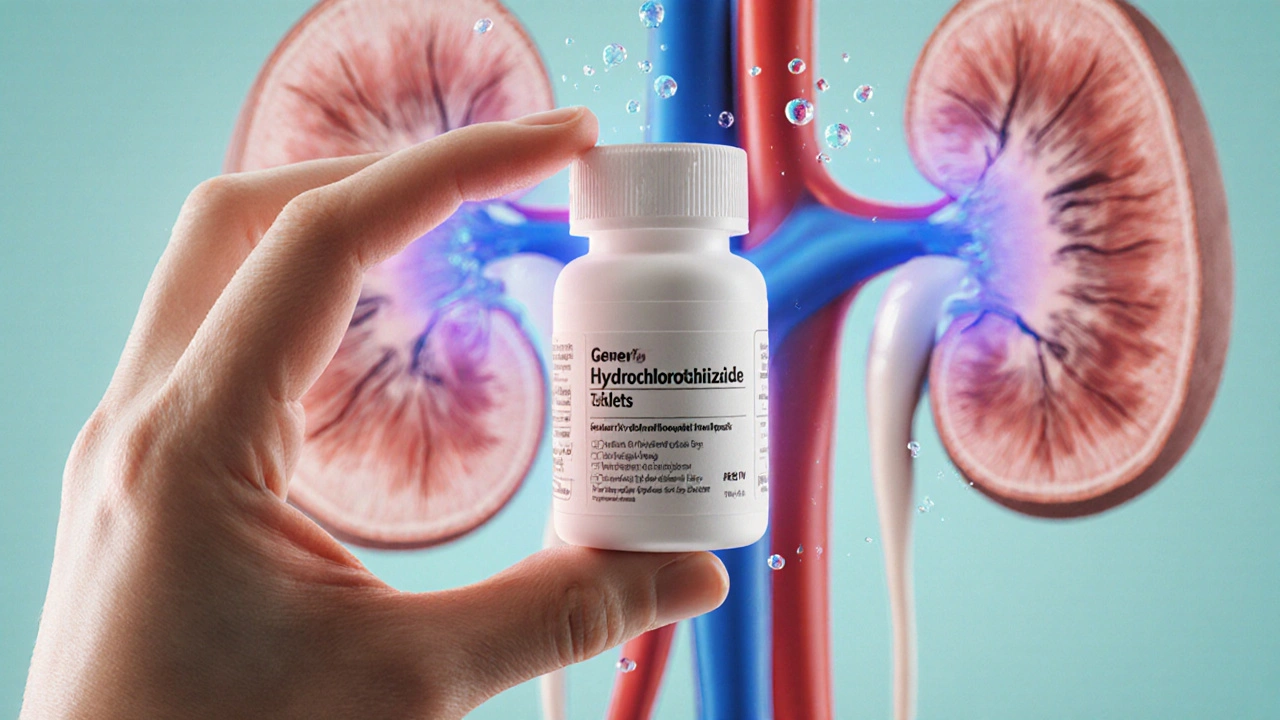Hydrochlorothiazide vs Diuretic Alternatives Comparison Tool
Recommended Diuretic Option:
Key Characteristics:
| Feature | Selected Option |
|---|---|
| Drug Class | |
| Typical Dose | |
| Duration of Action | |
| Main Uses | |
| Side Effects |
If you’ve ever been prescribed a pill to lower blood pressure or reduce swelling, chances are you’ve heard of Hydrochlorothiazide. But is it always the right choice? This guide breaks down how Hydrochlorothiazide stacks up against the most common alternatives, so you can see which drug fits your health needs best.
What is Hydrochlorothiazide?
Hydrochlorothiazide is a thiazide diuretic that helps the kidneys remove excess salt and water from the body. It first hit the market in the 1950s and quickly became a go‑to for treating hypertension and mild edema. The drug is usually taken once daily, often in combination with other blood‑pressure agents.
How Hydrochlorothiazide Works
The medicine targets the distal convoluted tubule in the kidney. By blocking the sodium‑chloride transporter, it reduces the reabsorption of sodium. Less sodium means less water follows, leading to a drop in blood volume and, consequently, blood pressure. This mechanism also makes it useful for reducing fluid buildup in conditions like heart failure.
Common Alternatives to Hydrochlorothiazide
When doctors consider a different diuretic, they look at the drug’s class, how long it works, and the side‑effect profile. Below are the most frequently prescribed alternatives, each with a brief snapshot.
- Chlorthalidone is another thiazide‑like diuretic, known for a longer half‑life, which can provide more stable blood‑pressure control.
- Indapamide sits between thiazides and loop diuretics, offering strong antihypertensive effects with fewer metabolic disturbances.
- Furosemide belongs to the loop diuretic family; it works faster and is the drug of choice for severe edema or acute heart‑failure decompensation.
- Spironolactone is a potassium‑sparing diuretic that also blocks aldosterone, making it useful for resistant hypertension and certain forms of heart failure.
- Amiloride is a mild potassium‑sparing agent, often paired with thiazides to counteract potassium loss.
Side‑Effect Profiles at a Glance
All diuretics can cause electrolyte shifts, but the magnitude and type differ. Hydrochlorothiazide tends to lower potassium and magnesium, while increasing uric acid - a factor in gout attacks. Loop diuretics like Furosemide can cause more pronounced dehydration and ototoxicity at high doses. Potassium‑sparing agents carry a risk of hyperkalemia, especially in patients with kidney impairment.
Head‑to‑Head Comparison
| Drug | Class | Typical Daily Dose | Duration of Action | Common Uses | Main Side Effects |
|---|---|---|---|---|---|
| Hydrochlorothiazide | Thiazide | 12.5‑50mg | ~12hours | Hypertension, mild edema | Low potassium, ↑ uric acid, ↑ glucose |
| Chlorthalidone | Thiazide‑like | 12.5‑25mg | 24‑48hours | Hypertension, resistant edema | Low potassium, ↑ calcium, ↓ magnesium |
| Indapamide | Thiazide‑like | 1.5‑2.5mg | ~24hours | Hypertension, heart failure | Low potassium (less than HCTZ), headache |
| Furosemide | Loop | 20‑80mg (single dose) | ~6hours | Acute pulmonary edema, renal failure | Dehydration, ototoxicity, low potassium |
| Spironolactone | Potassium‑sparing | 25‑100mg | ~24hours | Resistant hypertension, primary aldosteronism | Hyperkalemia, gynecomastia, menstrual changes |
When to Choose Hydrochlorothiazide Over Alternatives
If you need a once‑daily pill that’s inexpensive and works well for mild‑to‑moderate hypertension, Hydrochlorothiazide remains a solid first‑line option. Its long history means doctors are familiar with how it interacts with other common meds, such as ACE inhibitors or ARBs. Opt for it when:
- You have no history of gout or poorly controlled diabetes.
- Kidney function is stable (eGFR >60mL/min/1.73m²).
- Cost is a concern - generic versions cost pennies per tablet.
For patients who struggle with low potassium or frequent gout flares, a switch to Chlorthalidone or Indapamide might give similar blood‑pressure control with a milder impact on uric acid.
When an Alternative May Be a Better Fit
Consider the following scenarios:
- Severe fluid overload: Loop diuretics like Furosemide act faster and move more fluid per dose.
- Resistant hypertension: Adding Spironolactone can tackle aldosterone‑driven blood‑pressure spikes.
- Long‑acting control needed: Chlorthalidone’s 24‑48‑hour effect reduces the chance of “off‑hours” blood‑pressure spikes.
- Concern about calcium loss: Indapamide preserves calcium better than Hydrochlorothiazide, which can be useful for osteoporosis‑prone patients.

Dosing Tips and Practical Advice
Start low and go slow. Most clinicians begin Hydrochlorothiazide at 12.5mg daily, checking blood pressure after two weeks. If the target isn’t reached, increase to 25mg, then 50mg as needed. For alternatives, dosing schedules differ:
- Chlorthalidone: 12.5mg in the morning; avoid evening doses to prevent nocturia.
- Indapamide: usually once‑daily in the morning; take with food to improve absorption.
- Furosemide: can be taken once or divided doses; timing matters for patients on dialysis.
- Spironolactone: start at 25mg, titrate up; monitor potassium levels closely.
Never combine two thiazides; the additive effect on electrolyte loss can be dangerous.
Drug Interactions and Safety Checks
Because diuretics affect kidney function and electrolytes, they interact with many other drugs:
- ACE inhibitors/ARBs: Often synergistic, but monitor potassium and blood‑pressure drops.
- NSAIDs: Can blunt diuretic effect and raise kidney risk.
- Lithium: Thiazides raise lithium levels; dose may need reduction.
- Digoxin: Low potassium from Hydrochlorothiazide can increase digoxin toxicity.
Always have blood work done after a month of therapy - check sodium, potassium, chloride, bicarbonate, creatinine, and uric acid. Adjust doses based on labs, not just symptoms.
Quick Comparison Checklist
- Goal: mild hypertension vs. severe edema.
- Desired duration: 12h (Hydrochlorothiazide) vs. 24‑48h (Chlorthalidone/Spironolactone).
- Key side‑effects to avoid: gout (Hydrochlorothiazide), hyperkalemia (Spironolactone), ototoxicity (Furosemide).
- Cost sensitivity: Hydrochlorothiazide & Chlorthalidone are cheapest.
- Renal function: eGFR<30→avoid thiazides; consider loop diuretics.
Frequently Asked Questions
Can I switch from Hydrochlorothiazide to another diuretic on my own?
Never make the change without talking to your doctor. Different drugs require new dosing schedules and lab monitoring, so a professional should guide the transition.
Why does Hydrochlorothiazide sometimes raise blood sugar?
Thiazides can reduce insulin sensitivity and raise glucose levels, especially at higher doses. If you have diabetes, your doctor may prefer a lower dose or an alternative diuretic.
Is a once‑daily dose enough for controlling blood pressure?
For most people, yes. The 12‑hour action window covers daytime pressure peaks. If you notice early‑morning spikes, a longer‑acting option like Chlorthalidone might work better.
What should I look out for when taking Spironolactone alongside Hydrochlorothiazide?
Watch potassium levels closely. The two drugs have opposite effects on potassium, so the combo can balance out, but it also makes lab monitoring essential.
Do any of these diuretics help with weight loss?
They can cause temporary fluid loss, which may show up as a few pounds on the scale. This isn’t fat loss, and the weight often returns once the drug is stopped.


6 Responses
Hydrochlorothiazide works well for mild hypertension but watch potassium levels especially if you’re also on ACE inhibitors.
Hey folks 🙂 this drug is cheap and easy to take 😊 just remember to get your labs checked regularly.
When one peers into the vast tableau of diuretic therapy, the mind is struck by the profound gravitas of each molecule’s destiny.
Hydrochlorothiazide, the veteran of the thiazide class, steps onto the stage with a quiet confidence born of decades of clinical use.
Yet its modest half‑life whispers of fleeting presence, a reminder that even the stalwart can be eclipsed by its kin.
Enter chloro‑thalidone, the longer‑acting sibling, whose prolonged shadow stretches across the night, smoothing blood‑pressure peaks that would otherwise surge like tidal waves.
Indapamide, poised between worlds, offers the potency of a thiazide without the full weight of metabolic turmoil, a balanced sovereign in the kingdom of antihypertensives.
The loop diuretic furosemide bursts onto the scene with the ferocity of a storm, expelling fluid with unrelenting vigor, a true hero for acute pulmonary edema.
Spironolactone, the potassium‑sparing sentinel, guards against the depletion that haunts many of its brethren, while also curbing the aldosterone‑driven tyranny of resistant hypertension.
Each agent carries a chorus of side‑effects-potassium loss, uric acid rise, hyper‑kalemia-that echo through patient lives like distant thunder.
Clinical wisdom teaches us to match the drug to the patient’s terrain, balancing efficacy, duration, and tolerability.
Cost, too, wields its own influence, pulling the vulnerable toward the cheapest option even when a superior alternative looms just beyond reach.
Thus, the prescriber becomes a cartographer, mapping the intricate landscape of individual risk, comorbidities, and socioeconomic factors.
In the end, the choice of diuretic is not a mere checkbox but a nuanced dialogue between physician and patient.
Only through vigilant monitoring of electrolytes, renal function, and symptomatology can we ensure that the selected therapy remains a boon, not a burden.
So let us honor the legacy of hydrochlorothiazide while remaining ever‑watchful for the promise offered by its counterparts.
Ehh why ignore the potassium loss issue.
While your point regarding potassium is valid the clinical guidelines recommend monitoring serum levels regularly.
Nice job summarizing the basics keep it up and remember to check labs.